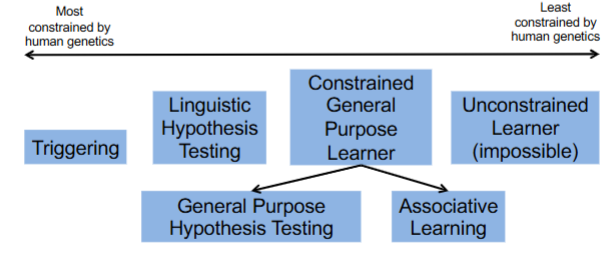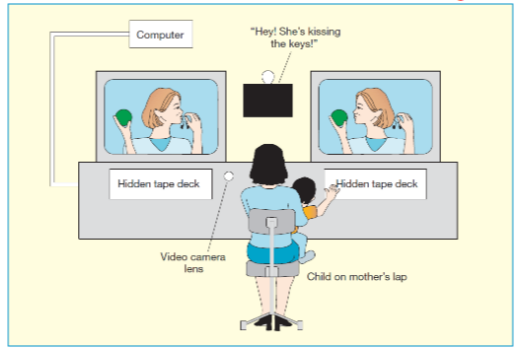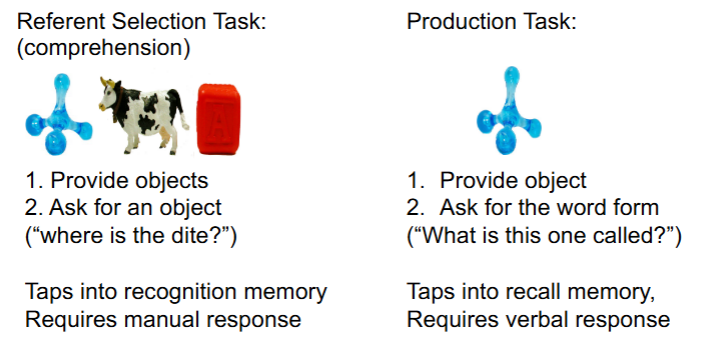Week 1 - Intro & theories
1/32
There's no tags or description
Looks like no tags are added yet.
Name | Mastery | Learn | Test | Matching | Spaced |
|---|
No study sessions yet.
33 Terms
why is language important?
it is related to several later outcomes
educational attainment
health
incarceration
how many children in the UK don’t have books?
3.8 million (national Literacy trust, 2011)
McCormack et al., 2010
case study - Ewan wouldn’t talk to others that didn’t understand him but would start talking when they talked to him first.
Norbury et al., 2016
2 children per reception class have clinically significant language deficits (no gender difference)
consequences of a language impairment
more social, emotional and behavioural problems
lower academic progress
what is a hypothesis?
A testable prediction
• Based on some previous
knowledge or observation
• “what happened?”
• Describes, explains
what is a theory?
comprehensive explanation
based on a large body of evidence
explains why/how
describes, explains and predicts future behaviour
explain Jorge Cham’s scientific method
observe natural phenomena
formulate hypothesis
test hypothesis
modify hypothesis
repeat
establish theory based on repeated validation of results
what is the role of theories?
guide experimental design
guide interpretation of results
what are the 5 qualities of good theories?
logically sound
testable
consistent with data
parsimonious (as simple as possible, but not simpler)
general and unified (brings many ideas together into one theory)
what are the benefits of models for testing theories?
they force researchers to be explicit about input and how learning is defined
they allow a deeper look at what has changed
can create predictions that can be tested to advance a theory
can test things that are not feasible with children due to time and ethics
explain the nature/nurture continuum (Gerken, 2008)
a scale of language development theories from most to least related to human genetics

what is interactionism?
the idea that a child learns from both nature and nurture (they come with a predisposition and the environment/input provides the rest)
explain dynamic systems theory (DST)
behaviour is made from many complex, interacting parts within a system (“soft assembly”)
not one single element that controls development
behaviour is the result of many elements interacting through time
interaction of parts changes over time - behaviour can become more stable/habitual/predictable
key points for triggering (Gerken, 2008)
specificity - language is distinct from other cognitive domains
what can be learned - children should not learn language-like patterns that don’t occur in language
learning speed - some things can be learned from single encounters
errors - errors should reflect possible languages
keys points of linguistic hypothesis theory (Gerken, 2008)
specificity - language is distinct from other cognitive domains
what can be learned - children should not learn language-like patterns that don’t occur in language
learning speed - learning can be rapid but is based on input
errors - errors should reflect incorrect hypotheses about the input
keys points of general purpose hypothesis testing (Gerken, 2008)
specificity - learning language should resemble learning in other cognitive domains
what can be learned - children can learn language-like patterns that do not occur in language
learning speed - learning can be rapid but is based on input
errors - errors should reflect incorrect hypotheses about the input
key points for associative learning (Gerken, 2008)
specificity - learning language should resemble learning in other cognitive domains
what can be learned - children can learn language-like patterns that do not occur in language
learning speed - learning should be gradual and based on input
errors - errors should reflect the statistics of the input
what role does time play in dynamic systems theory
development in continuous in time
time scales can be years, months, days, etc.
accounts for both “real time” changes (seconds, mins) and “developmental time” (months, years)
behaviour is a product of a child’s history, current environment, current task
what are nested timescales?
learning is the culmination of a child is doing the moment, their recent past, and developmental history
challenges of testing children
task can’t be too easy/hard
can’t be too long
children under 4 are biased to answer ‘yes’ (Cameron-Faulkner, Lieven & Theakston, 2007)
children are susceptible to inadvertent cues (Grow & LeBlanc, 2013)
children are biased to chose novel objects (Horst et al., 2011)
can only learn up to 3-4 words a day (Bion et al., 2013)
you have to ‘guess’ what children are thinking
why do many studies use novel (pseudo) words?
to avoid a priori associations/knowledge
explain the intermodal preferential looking task (Hirsh-Palek & Golinkoff, 1996)
children sit on lap on parent and are shown two screens (sometimes one)
attention will be centred
children are filmed
children will hear a spoken sentence about one of the images and then their looking can be assessed to see if they look at the correct one
tells us about how a child understands the sentence

explain looking tasks
training phase - looked at familiar objects and then novel objects
test phase - two things presented on the screen and then heard speech relating to one of the objects
eye-tracking to see whether they looked at the correct object
switch task (Fennell & Byers-Heinlein, 2014)
train a child with two images with certain words (habituation)
switch the words and images so they are incorrect
child should (hopefully) spend more time looking at the incorrect match
what is a forced-choice task?
2AFC/3AFC etc. (alternative forced choice)
making children pick one word/object from a collection in response to a question/request
communicative development inventory (CDI)
used to make sure not all children of higher language abilities are in the same condition
used to make sure that they do/don’t know the word(s) being used in the experiment
MacArthur-Bates CDI: words and gestures/words and sentences
peabody picture vocabulary test
standardised vocab test for 3y - 16y 11m
4 alternative photos
point to/say number of picture that matches a word
what is a corpus?
a collection of real words, utterances and sentences
often it is a transcription of children and parents speaking, reading, playing etc.
sometimes it is a list of words found in books of a certain level
example: CHILDES (child language data exchange system)
what is mean length of utterance (MLU)
the average meaning units (morphemes) per utterance
different task demands (Gordan & McGregor, 2014)
referent selection task (comprehension, recognition memory, manual response)
provide multiple objects and then ask for one specific object
production task (recall memory, verbal response)
provide an object and ask for the word form (i.e. name)

explain the dot task (Gordon & McGregor, 2014)
a form of production task
allows a child to give a manual response instead of a verbal response
place objects on the dots and then later ask the child which dot refers to which object
comprehension vs production
comprehension precedes production (Caselli et al., 2012)